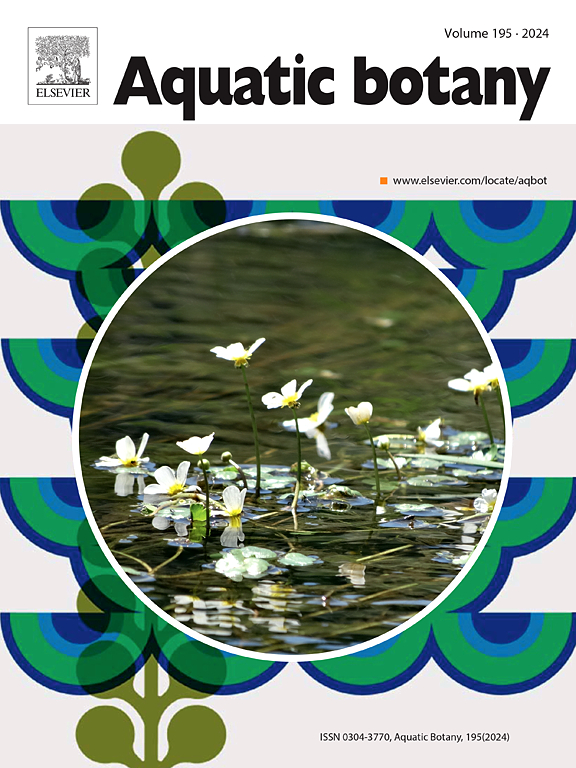Differential responses of Bolboschoenus planiculmis and Phragmites australis to hydroperiod and nitrogen supply
IF 2.6
4区 生物学
Q2 MARINE & FRESHWATER BIOLOGY
引用次数: 0
Abstract
Bolboschoenus planiculmis and Phragmites australis are two wetland plants found in Momoge National Nature Reserve (MNNR) in northeastern China. Recently, the water depth in this region has substantially increased during peak plant growth phases due to return flow from nearby paddy fields. The total nitrogen (TN) concentration of the water in the wetland’s inlet is 1.153 ± 0.112 mg/L. During this study, artificial ponds were used to simulate these natural changes. Experiments were then conducted to examine the response of growth, the ramet number, the biomass accumulation, and the allocation of the two aforementioned species in different hydroperiods (a static water depth and an increasing water depth) and soil nitrogen conditions (0.5, 1.1, and 1.7 mg g⁻¹ TN). We found that P. australis demonstrated a significantly higher biomass accumulation, plant height, and ramet number under the greater water depth compared to the 30 cm static water depth. In contrast, B. planiculmis’ values were substantially lower under the increasing water depth than those under the 10 cm static water depth. P. australis exhibited an initial increase followed by a decline in response to nitrogen addition, independent of hydroperiod conditions. Conversely, under static water conditions, B. planiculmis’ total biomass and aboveground biomass increased significantly with the addition of nitrogen. This indicates that the interaction between the nitrogen supply and the hydroperiod of wetland plants is species-specific and dependent on nitrogen availability. Although an increased nitrogen supply resulted in higher belowground biomass, plant height, and ramet and tuber numbers for B. planiculmis under the increasing water depth, these values were still significantly lower than those under the static water conditions. This indicates that nitrogen enrichment did not counteract the negative effects of the increasing water depth on B. planiculmis’ growth. The findings of this experiment will help predict the vegetation dynamics of MNNR wetlands under future habitat changes driven by the return flow from paddy fields.
扁豆和芦苇对水周期和氮供应的差异响应
扁桃草(Bolboschoenus planiculmis)和芦苇(Phragmites australis)是在中国东北莫莫格国家级自然保护区发现的两种湿地植物。近年来,由于附近水田的回流,该地区的水深在植物生长高峰期大幅增加。湿地进水总氮(TN)浓度为1.153 ± 0.112 mg/L。在本研究中,采用人工池塘模拟这些自然变化。在不同的水期(静水深和增加水深)和土壤氮(0.5、1.1和1.7 mg g⁻¹TN)条件下,对上述两种植物的生长、株数、生物量积累和分配的响应进行了研究。结果表明,与30 cm静水深相比,在较大水深下,南菖蒲的生物量积累、株高和分株数均显著增加。相比之下,增加水深下的平棘球蚴值明显低于10 cm静水深下的平棘球蚴值。对氮添加的响应表现出先增加后下降的趋势,与水期条件无关。相反,在静态水分条件下,随着氮素的添加,平梭鲈的总生物量和地上生物量显著增加。这表明湿地植物的氮供应与水期之间的相互作用具有物种特异性,并依赖于氮的有效性。增加氮素供给量后,随着水深的增加,平顶扁柏的地下生物量、株高、分株和块茎数量均显著增加,但仍显著低于静水条件下。这说明富氮并不能抵消水深增加对平棘双歧杆菌生长的负面影响。本研究结果将有助于预测未来水田回流驱动下MNNR湿地的植被动态变化。
本文章由计算机程序翻译,如有差异,请以英文原文为准。
求助全文
约1分钟内获得全文
求助全文
来源期刊

Aquatic Botany
生物-海洋与淡水生物学
CiteScore
3.80
自引率
5.60%
发文量
70
审稿时长
6 months
期刊介绍:
Aquatic Botany offers a platform for papers relevant to a broad international readership on fundamental and applied aspects of marine and freshwater macroscopic plants in a context of ecology or environmental biology. This includes molecular, biochemical and physiological aspects of macroscopic aquatic plants as well as the classification, structure, function, dynamics and ecological interactions in plant-dominated aquatic communities and ecosystems. It is an outlet for papers dealing with research on the consequences of disturbance and stressors (e.g. environmental fluctuations and climate change, pollution, grazing and pathogens), use and management of aquatic plants (plant production and decomposition, commercial harvest, plant control) and the conservation of aquatic plant communities (breeding, transplantation and restoration). Specialized publications on certain rare taxa or papers on aquatic macroscopic plants from under-represented regions in the world can also find their place, subject to editor evaluation. Studies on fungi or microalgae will remain outside the scope of Aquatic Botany.
 求助内容:
求助内容: 应助结果提醒方式:
应助结果提醒方式:


